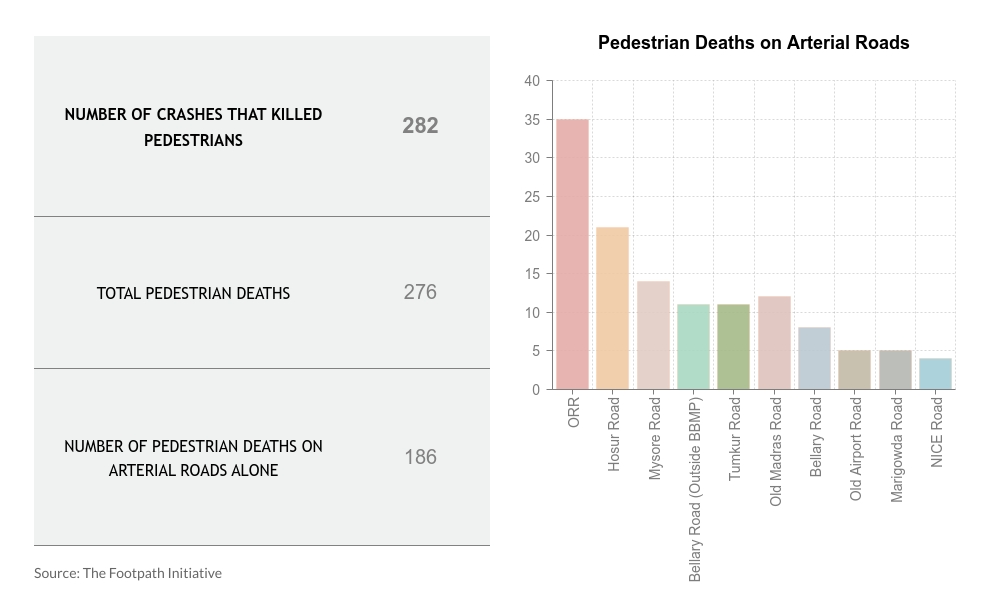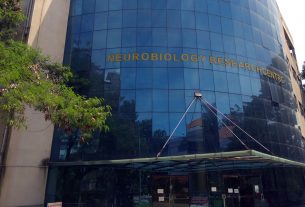Bangalore has the third-highest number of pedestrian deaths among the eight metro cities in India.
By Arghyadeep Dutta
Arterial roads of Bengaluru are still the most dreadful roads to cross, as in 2018, the roads claimed the lives of nearly two-third of the pedestrian crashes. The data was obtained by a Non-Governmental Organization -The Footpath Initiative- in 2019 through Right To Information (RTI) applications filed with 44 traffic police stations in Bengaluru.
A study by the NGO states that Bangalore has the third-highest number of pedestrian deaths among eight metro cities in India. In 2018, among 276 pedestrians killed in an accident in the city, 186 were in the arterial roads.

The study covered Bengaluru’s estimated 80 arterial roads, with a total distance of around 923 km. Among the total fatalities, nearly 66 per cent are from arterial roads like Mysore Road, Old Madras Road, Hosur Road, Tumkuru Road and the 80 km long Outer Ring Road (ORR), a sub-arterial road, which covers about 0.5 per cent of the city’s total road network contributed nearly 12 percent of the deaths.
Bruhat Bengaluru Mahanagara Palike defines an arterial road as a high-capacity urban road with the function to deliver traffic from collector roads to freeways, and between urban centres at the highest level of service possible and to move vehicles with minimal obstruction, whereas, a sub-arterial road is an urban road primarily for through traffic usually on a continuous route but offering a somewhat lower level of traffic mobility than the arterial street.

The study noted that 70 per cent of the victims were residing in areas adjoining the arterial roads and for whom access to arterial roads was extremely crucial daily. Moreover, most of the victims are from the low-income group, with half of them working as a security guard or a housemaid or as drivers. Almost a third of the cases were registered as hit and run cases where the motorist was at high speed.
“We have noticed the death rates. BBMP has erected footbridge in many of the places in ORR, but only a handful of people use them. In the case of arterial roads, most of them join the National Highway, and it is not possible to add crossing and signals. For arterial roads, the pedestrians must be careful while crossing the roads. In October 2019, the Department of Urban Land Transport had drafted a new ‘Mobility Plan’ where footpaths and elevated walkways are being built on arterial roads,” said B. R. Ravikanthe Gowda, Additional Commissioner of Police (Traffic).
“Since most of the deaths are happening in arterial roads and peripheral roads, the primary task is to design the roads in a better way. There should be a safeguard on the roads to prevent pedestrians from crossing haphazardly, and there should be a midblock in between the two lanes of a road where pedestrians can stand while crossing the road,” said Anil Bhaskaran, an urban planner.
An experiment by The Footpath Initiative revealed that to cross the 15-meters-wide Hosur Road the time available is five seconds, but as per the recommendation of Indian Road Congress Guidelines (93:1985), the time taken to cross the road should be calculated based on the fact that a person is moving at a speed of 1.2 meters per second. Moreover, ichangemycity’s Bengaluru segment has a street quality rating map where one can get to know much walkable a footpath is or how much crossable an intersection is, and it scored Hosur Road’s intersection crossability zero per cent.


